Overview of Supply Chain Orchestration
Use Oracle Supply Chain Orchestration to manage supply for your items, and to make sure fulfillment is consistent and efficient.
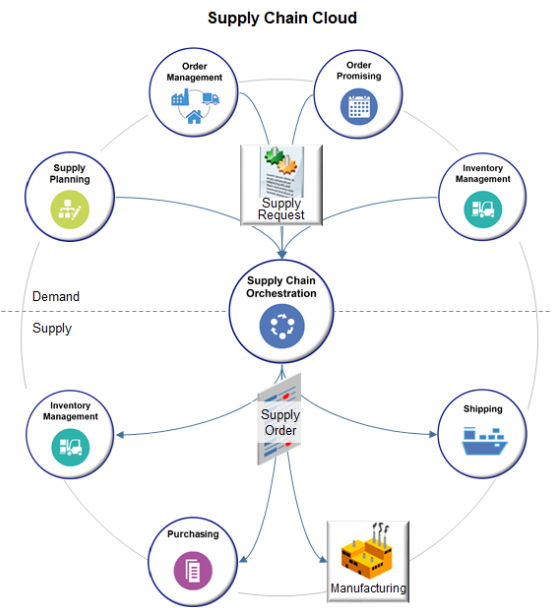
Manage supply from one, central location.
-
Receive a supply request to meet demand from an Oracle application, such as Oracle Supply Planning, Oracle Order Management, Oracle Order Promising, or Oracle Inventory Management.
-
Send a supply order to fulfill supply in an Oracle application during fulfillment, such as Inventory Management, Purchasing, Manufacturing, and Shipping.
-
Create business rules that manage supply.
-
Manage supply from one location.
-
Start and manage a complex business process that creates supply in the warehouse to fill your anticipated demand.
-
Automate change management that matches supply to demand and makes sure you balance quantity and fulfillment dates. Use automated exception management to avoid creating excess supply or not having enough supply to fulfill each sales order. Balance supply with demand on each order to meet your customer satisfaction and profitability goals.
-
Use a 360 degree view to monitor the process that creates supply and the relationship between different documents in the process.
You capture a sales order, configure it if its a configured item, price it, promise it, then orchestrate fulfillment.
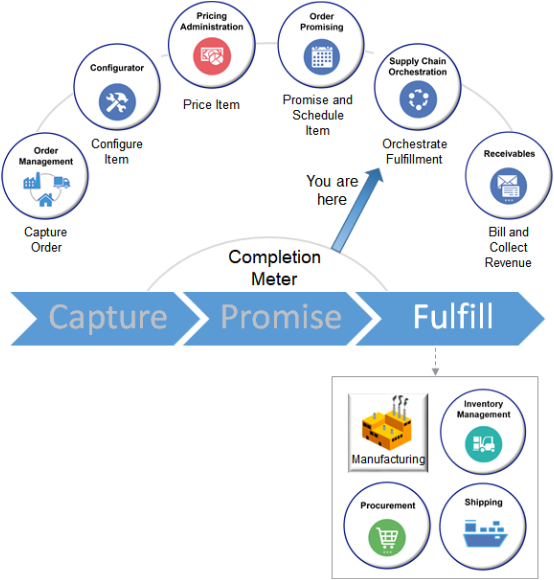
You orchestrate fulfillment differently depending on the flow.
-
Back-to-back flow, such as make, buy, or transfer. Supply Chain Orchestration combines the demand from Order Management and the supply suggestion from Global Order Promising to create the supply document in each back-to-back flow.
-
Drop shipment from your supplier to your customer
-
Internal material transfer
-
Contract manufacturing
-
Consigned inventory
These flows come predefined to automatically process supply, but you can modify them to meet your requirements.
Manage Supply for Back-to-Back Flows
Automate your back-to-back flow. Back-to-back means Supply Chain Orchestration processes the supply request one step after the other, consecutively, and directly.
Use back-to-back when the item is expensive to maintain as on hand inventory, or when you don't want to use up warehouse space to stock an item that only rarely sells.
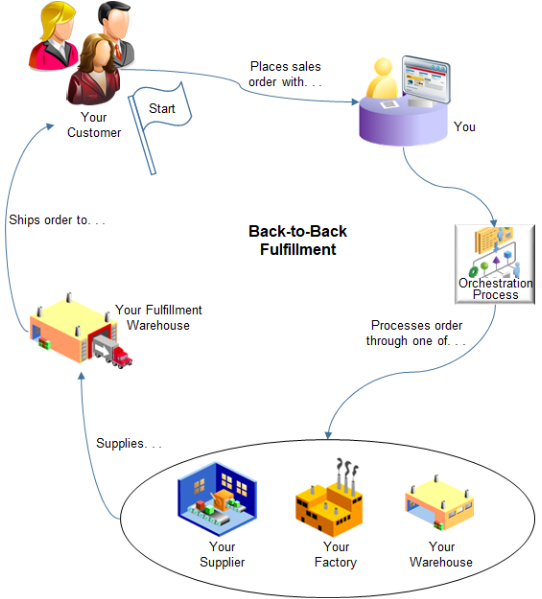
Note
-
Your customer places a sales order through your order capture system.
-
A predefined orchestration process that's already optimized for back-to-back fulfillment reserves supply in your supplier's factory, your factory, or your warehouse.
-
The factory or warehouse supplies your fulfillment warehouse.
-
Your fulfillment warehouse ships the sales order to your customer.
For example, specialized medical or scientific equipment might not be practical to store in a warehouse because its physically large, or its very expensive to build. Your customers only rarely order the equipment, and when they do, you specialize it for each customer. The medical facility orders the specialized equipment, then sourcing rules determine whether to make the equipment in house or procure it from a supplier. The manufacturing or procurement process finishes, ships it to your warehouse, and your warehouse ships it to the medical facility.
In another example, warehouse space might be expensive in your area. So you stock items in a less expensive location. A customer of yours who resides close to the expensive area orders the item. The back-to-back flow transfers the item from the less expensive location to a warehouse close to your customer, then ships it.
Here are the types of back-to-back flows you can fulfill.
-
Make
-
Buy
-
Transfer
For details, see Use Supply Chain Orchestration in Your Back-to-Back Flows.
Manage Supply for Drop Ship Flows
Automate your drop ship flow. Instead of creating and keeping the item in your own inventory, your supplier or contract manufacturer creates, stores, and ships the sales order to your customer.
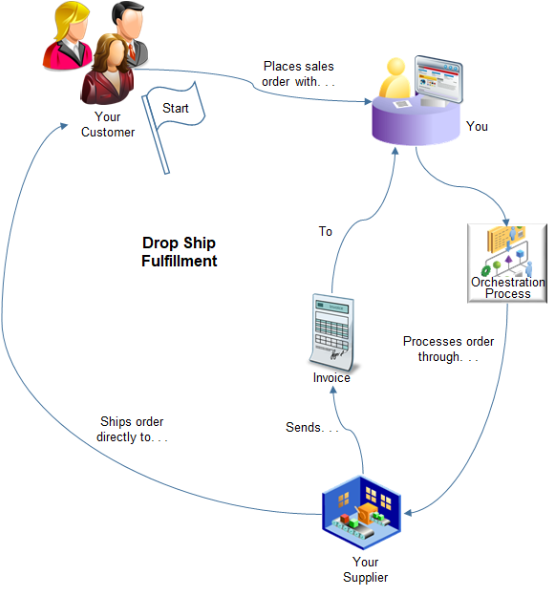
Note
-
Your customer places a sales order through your order capture system.
-
A predefined orchestration process that's optimized for drop ship fulfillment sends a purchase order for the item to your supplier, including instructions for shipping directly to your customer.
-
Your supplier creates the item or picks it from inventory, then ships it to your customer.
-
Your supplier sends an invoice or advance shipment notice to you.
Manage Supply for Transfer Flows
Automate your transfer flow. Use a single flow to transfer material between two different organizations, between different sections in the same organization, or between companies.
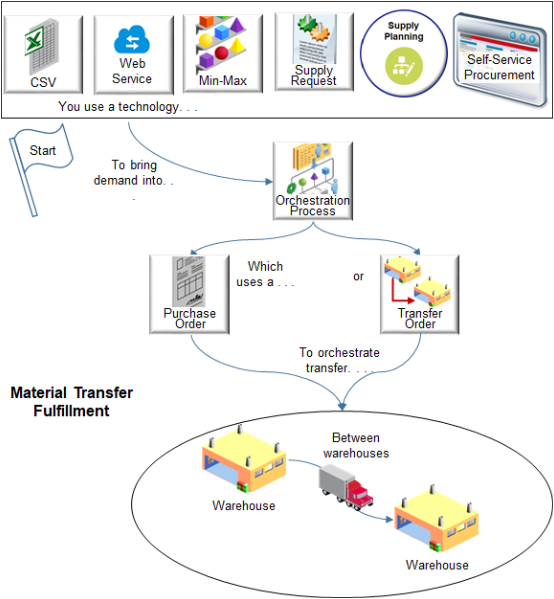
Note
-
Use a technology to bring demand into your flow.
-
File-based data import
-
Web service
-
Inventory management, such as min-max planning
-
Manage Item Quantity of a supply request from a back-to-back flow
-
Supply planning
-
Requisition line in Self-Service Procurement
-
-
A predefined orchestration process that's optimized for material transfer fulfillment uses a purchase order or a transfer order to orchestrate the transfer. For example, between two different warehouse.
For details, see Overview of Internal Material Transfers.
Automate Change Management
Supply Chain Orchestration comes predefined to use a comprehensive set of predefined change management rules to automate change.
-
Match supply to demand to prevent excess inventory. Excess inventory is expensive and isn't necessary.
-
Automate change management and reduce the cost of handling exceptions.
-
Reduce errors that happen with manual change.
-
No set up is necessary.
Supply Chain Orchestration automatically manages change and keeps demand and supply in balance.
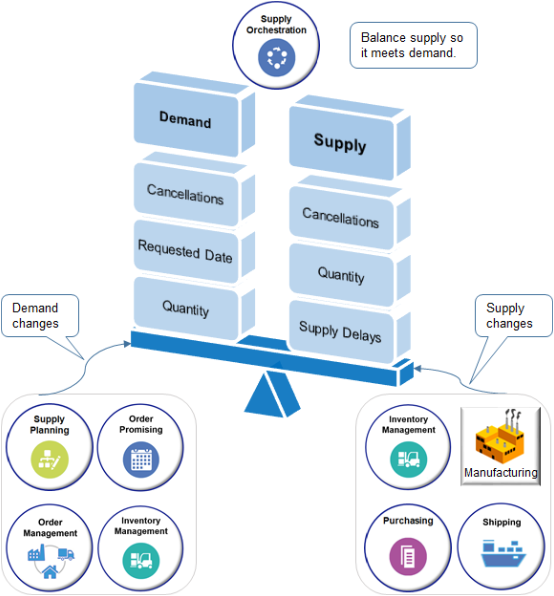
Use change management to maintain a balance between quantity and fulfillment dates. Do it when a change happens.
-
The demand changes something.
-
Change the quantity of a sales order.
-
Change the requested date of a sales order.
-
Cancel a sales order, purchase order, transfer order, or work order.
-
Split a sales order, purchase order, or transfer order.
-
-
The source, such as a supplier or manufacturer, changes something.
-
Increase or decrease the supply quantity.
-
Change the date when supply becomes available.
-
Split supply. Make the total quantity available in more than one delivery.
-
Cancel a supply order.
-
Assume your customer requests to reduce the line quantity on a back-to-back sales order from 10 to 5, so your fulfillment organization changes the quantity. Supply Chain Orchestration receives the request and updates the quantity on the supply document, which is the purchase order in this example. If Supply Chain Orchestration didn't automatically process the change then your supplier would have supplied more inventory than you need
Change that happens commonly in your supply chain might require manual intervention, increasing the possibility of error and delay and cause bottlenecks in order fulfillment. Supply Chain Orchestration automatically manages change so you don't have to manually do it.
Supply Chain Orchestration attempts to change supply to match demand so it satisfies the new condition. If it can't, then it creates an exception and notifies the fulfillment system, such as Order Management.
Example
Assume your supplier reduces the purchase order quantity in a back-to-back flow.
-
Demand quantity is 100 units.
-
Purchase order quantity is 100 units.
-
Supplier reduces supply quantity to 75 units.
Here's how Supply Chain Orchestration manages the change.
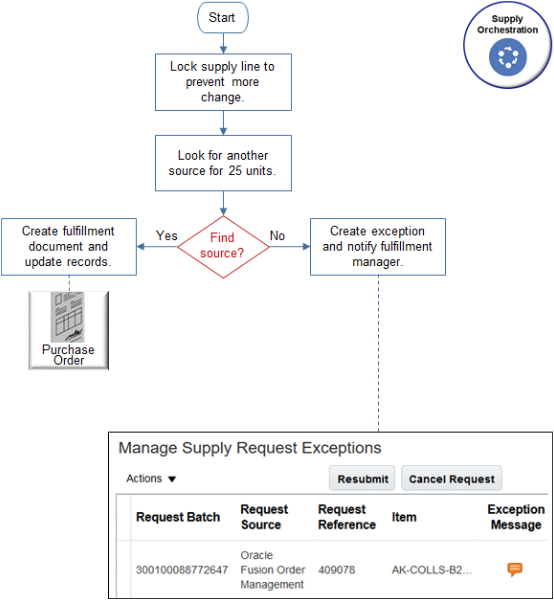
Here's what Supply Chain Orchestration does.
-
Locks the supply line to prevent more change.
-
Looks for another supply source that can fulfill 25 units.
-
If Supply Chain Orchestration:
-
Finds another source. Creates fulfillment document and update records. In this example, a purchase order is the fulfillment document.
-
Doesn't find another source. Creates exception and notifies fulfillment manager. You can use the Manage Supply Exception Requests page in the Supply Orchestration work area to manage exceptions.
-
Manage Exceptions
Get status updates while Supply Chain Orchestration creates supply. For example, view errors, exceptions, and jeopardy for supply that's at risk of not meeting fulfillment. If an exception happens, then use predefined rules to reduce excess inventory and find another source for your supply.
Identify the cause of an exception. Access the supply document to get details, such as the manufacturing work order or purchase order. Resolve the supply risk, then resubmit the supply order. If you can't resolve the risk, then you can cancel the supply request.